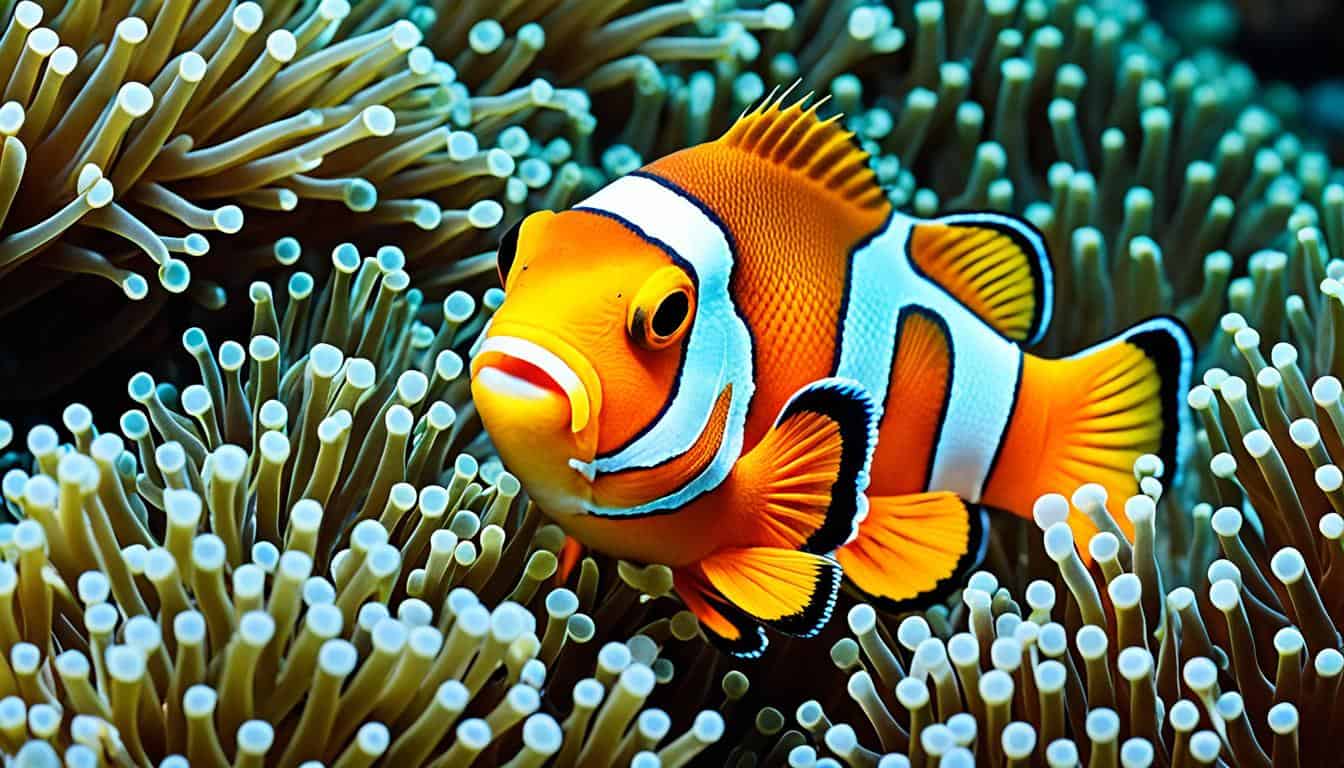Clownfish are a big deal in the marine world, loved by many and vital to their homes. You might ask, how many types of clownfish are there? These fish, also known as anemonefish, are part of the Pomacentridae family. They have about 30 recognized species spread across two groups: Amphiprion and Premnas. Their bright colors and unique looks make them a hit with people who keep fish tanks.
Clownfish live in the warm waters of the Indian, Pacific Oceans, and the Red Sea. They live with sea anemones, forming a special bond. This relationship protects them and shows how important they are in the ocean’s balance. The ocellaris clownfish, known as ‘Nemo’ from movies, is a great example of their charm and role in nature.
Overview of Clownfish
Clownfish are known for their bright colors and interesting behaviors. They are a key part of many marine ecosystems. Learning about their clownfish classification and clownfish taxonomy helps us understand their roles and how they adapt. These fish live in shallow coral reefs and have a special relationship with sea anemones.
Classification and Family
Clownfish belong to the family Pomacentridae. They are split into two main groups: Amphiprion and Premnas. Most species are in the Amphiprion genus, while the Premnas includes only the maroon clownfish. This shows how diverse and adaptable they are.
Habitat and Distribution
Clownfish live in warm, shallow waters with coral reefs. They often live near sea anemones for safety and food. You can find them in the Indian Ocean and the western Pacific Ocean, from eastern Africa to Australia. Some species, like the Clark’s clownfish, live in a wide area, while others, like the Oman anemonefish, stick to a smaller area. This shows how they have different ecological roles.
What are the different species of clownfish?
Clownfish are part of the family Pomacentridae and mainly belong to the genus Amphiprion. There are about 30 different clownfish species. They come in various colors, sizes, and behaviors, making them popular in marine tanks. Each type of clownfish has its own special traits and adaptations.
List of Recognized Species
| Common Name | Scientific Name | Notable Traits |
|---|---|---|
| Ocellaris Clownfish | Amphiprion ocellaris | Recognizable orange color with white bands. |
| Percula Clownfish | Amphiprion percula | Similar to Ocellaris but with brighter coloration and more distinct black margins. |
| Maroon Clownfish | Amphiprion biaculeatus | Deep maroon coloration with white stripes; larger than most clownfish species. |
| Clarkii Clownfish | Amphiprion clarkii | Strongly territorial with robust body; adapts well to captivity. |
| Tomato Clownfish | Amphiprion frenatus | Vibrant red coloration; a hardy clownfish subspecies. |
| Saddleback Clownfish | Amphiprion polymnus | Black and white markings with a distinctive saddle-shaped pattern on the back. |
| Pink Skunk Clownfish | Amphiprion perideraion | More subdued pink coloration; often found in more sheltered habitats. |
| Cinnamon Clownfish | Amphiprion melanopus | Distinct brown-orange color; adapt well to aquarist environments. |
| Sebae Clownfish | Amphiprion sebae | Typically yellow-orange; can change color based on environment. |
Popular Types of Clownfish
Clownfish are known for their bright colors and fun personalities. The Ocellaris clownfish and the Percula clownfish are the most common types found in aquariums. Each species has its own special traits that make them popular among marine lovers.
Ocellaris Clownfish: The Famous ‘Nemo’
The Ocellaris clownfish, also called ‘Nemo,’ stands out with its bright orange color and white bars. It can grow up to 4 inches long and needs a tank of at least 20 gallons. This fish is friendly and doesn’t get territorial easily, making it great for new fish keepers.
Because of its popularity, many different types of Ocellaris clownfish are available in the market. This has made them even more appealing to a wider audience.
Percula Clownfish: A Closer Look
The Percula clownfish looks similar to the Ocellaris but has thicker black bands. It grows to about 3.5 inches long and lives near the Great Barrier Reef. This fish can be a bit feisty but gets along well with peaceful fish like gobies and blennies.
Like the Ocellaris, the Percula clownfish has been bred to create many different variations. This has made it a favorite among fish enthusiasts.
Unique Traits of Clownfish Species
Clownfish are beloved for their eye-catching looks and fun behaviors. They are popular in both marine gardens and home aquariums. Their unique clownfish traits include different colors and sizes, making them stand out to both experts and hobbyists.
Color Variation and Patterns
The range of clownfish colors is stunning, featuring vibrant oranges, reds, yellows, blacks, and whites. These colors often create various patterns, from solid colors to detailed stripes and spots. For instance, the Ocellaris clownfish is known for its bright orange body with black stripes. These clownfish variations in color and pattern make them a treat to see in the wild or in aquariums.
Size and Growth Rates
Clownfish sizes can vary greatly among species. The Maroon clownfish can grow up to 6 inches, while the Percula clownfish reaches about 3.5 inches. These size differences are important to consider when picking a clownfish for your tank. Growth rates also change based on the environment, diet, and tank conditions. With the right care, most species can live a long time in captivity. Knowing these factors can make caring for these fish more rewarding.

Understanding Clownfish Behavior
Clownfish behavior is fascinating and shows their complex social life and how they interact. They live in groups with a clear leader, usually a dominant female. This group has one male and several smaller fish. This setup keeps peace and order in the group.
Social Structure and Aggression
The way clownfish live together affects how they act and fight. For example, the Maroon clownfish is very protective of its territory. It can be quite aggressive, especially in small tanks. On the other hand, the Ocellaris clownfish is calmer and gets along well with other fish.
Knowing about these traits is key when setting up a tank for clownfish. A peaceful tank reduces fighting and supports a healthy social life. Different clownfish species behave differently, which is important to consider when choosing tank mates.
Choosing Clownfish for Your Aquarium
Adding clownfish to your aquarium requires careful thought. Start by checking if different clownfish types get along. Some can be aggressive, especially with other fish. For peaceful ones like the Ocellaris or Percula, a 20-gallon tank is a good size. This gives them enough room to swim and lowers stress.
Think about what each clownfish species needs. Beginners can start with many types, but some, like the Maroon clownfish, need a big tank to themselves. Make sure you know what each fish needs for its health, including tank size, tankmates, and anemones.
Keeping your tank clean and the water right is key for your clownfish’s health. Regularly change the water and check on the fish to avoid sickness. By choosing the right clownfish and setting up a great home, you’ll love having these colorful fish in your aquarium.
FAQ
What are the different species of clownfish?
There are about 30 types of clownfish, mostly in the Amphiprion genus. Well-known ones are the Ocellaris, Percula, and Maroon clownfish.
How are clownfish categorized?
Clownfish are in the Pomacentridae family. They are split into two main groups: Amphiprion and Premnas. Amphiprion has most species, and Premnas has just the Maroon clownfish.
Where can clownfish be found in nature?
Clownfish live in the warm waters of the Indian and Pacific Oceans. They are found in shallow coral reefs and live with sea anemones.
What are some popular types of clownfish?
The Ocellaris and Percula clownfish are very popular. They are known for their bright colors and are easy to care for.
Do clownfish exhibit different color variations?
Yes, clownfish come in many colors like oranges, reds, yellows, and blacks. Each type has its own unique look.
What is the average size of clownfish?
Clownfish sizes vary. The Maroon can grow up to 6 inches, but the Percula usually reaches about 3.5 inches.
How do clownfish behave in social settings?
Clownfish live in groups with a dominant female leading. Some, like the Maroon, are more territorial than others, like the Ocellaris.
What should I consider when choosing clownfish for my aquarium?
Think about how well different species get along, your tank size, and how much upkeep you can handle. Beginners might like the Ocellaris or Percula, but the Maroon needs a bigger, special home.







